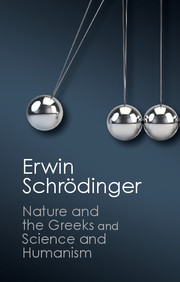Book contents
- Frontmatter
- Contents
- Foreword
- NATURE AND THE GREEKS
- SCIENCE AND HUMANISM
- Dedication
- Preface
- The spiritual bearing of science on life
- The practical achievements of science tending to obliterate its true import
- A radical change in our ideas of matter
- Form, not substance, the fundamental concept
- The nature of our ‘models’
- Continuous description and causality
- The intricacy of the continuum
- The makeshift of wave mechanics
- The alleged break-down of the barrier between subject and object
- Atoms or quanta-the counter-spell of old standing, to escape the intricacy of the continuum
- Would physical indeterminacy give free will a chance?
- The barto prediction, according to Niels Bohr
The makeshift of wave mechanics
Published online by Cambridge University Press: 05 October 2014
- Frontmatter
- Contents
- Foreword
- NATURE AND THE GREEKS
- SCIENCE AND HUMANISM
- Dedication
- Preface
- The spiritual bearing of science on life
- The practical achievements of science tending to obliterate its true import
- A radical change in our ideas of matter
- Form, not substance, the fundamental concept
- The nature of our ‘models’
- Continuous description and causality
- The intricacy of the continuum
- The makeshift of wave mechanics
- The alleged break-down of the barrier between subject and object
- Atoms or quanta-the counter-spell of old standing, to escape the intricacy of the continuum
- Would physical indeterminacy give free will a chance?
- The barto prediction, according to Niels Bohr
Summary
Now I shall try to give you an idea of the way in which physicists at present endeavour to overcome this failure. One might term it an ‘emergency exit’, though it was not intended as such, but as a new theory. I mean, of course, wave mechanics. (Eddington called it ‘not a physical theory but a dodge—and a very good dodge too’.)
The situation is about as follows. The observed facts (about particles and light and all sorts of radiation and their mutual interaction) appear to be repugnant to the classical ideal of a continuous description in space and time. (Let me explain myself to the physicist by hinting at one example: Bohr's famous theory of spectral lines in 1913 had to assume that the atom makes a sudden transition from one state into another state, and that in doing so it emits a train of light waves several feet long, containing hundreds of thousands of waves and requiring for its formation a considerable time. No information about the atom during this transition can be offered.)
So the facts of observation are irreconcilable with a continuous description in space and time 5 it just seems impossible, at least in many cases.
- Type
- Chapter
- Information
- 'Nature and the Greeks' and 'Science and Humanism' , pp. 143 - 151Publisher: Cambridge University PressPrint publication year: 2014



